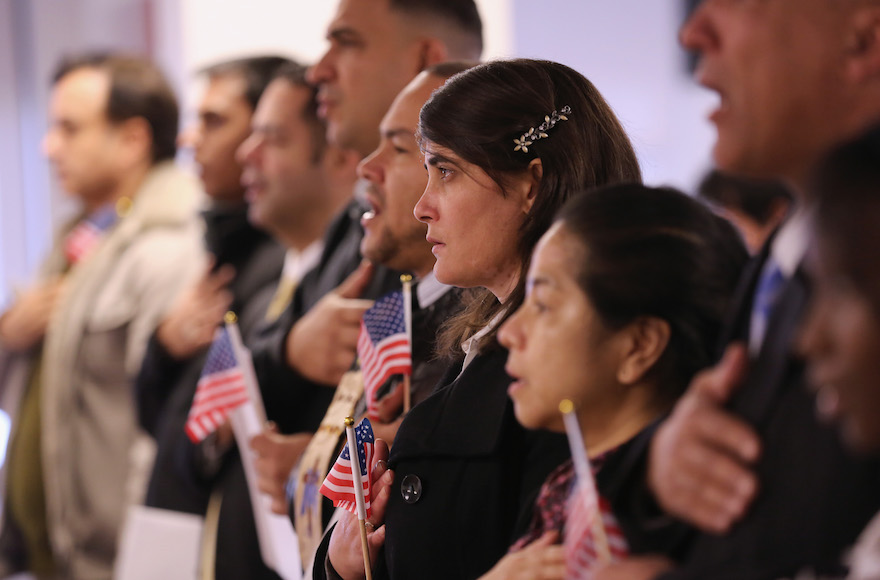WASHINGTON (JTA) — How extreme does vetting need to be to keep anti-Semites from entering the United States, and is Donald Trump’s plan worth the effort?
The Republican nominee’s proposal to apply an ideological test to potential immigrants is based on precedent: The United States in the last century instituted a broad ban on communists and their sympathizers, and Jewish groups after World War II sought to extend similar strictures to those who sympathized with Nazis.
Nonetheless, Jewish civil rights and immigration groups today have questions about the viability of Trump’s proposal and whether it is ethical to institute an ideological litmus test on arrivals from countries with vastly different values and education systems.
Trump in his Aug. 15 speech noted the precedent.
“In the Cold War, we had an ideological screening test,” he said. “The time is overdue to develop a new screening test for the threats we face today. I call it extreme vetting. I call it extreme, extreme vetting.”
Among those excluded, Trump said, would be anti-Semites.
“As we have seen in France, foreign populations have brought their anti-Semitic attitudes with them,” he said.
Trump also would extend his ban to those who are intolerant of other minorities, including the LGBTQ community, and to those who would seek to impose Islamic religious law on the United States.
The Trump campaign did not reply to a JTA request for elaboration on how Trump’s proposal would practically work.
Melanie Nezer, the vice president of policy for HIAS, the Jewish group leading advocacy for refugees, said current practice excludes immigrants who have actively participated in persecution, including having belonging to a terrorist group. Seeking to root out anti-Semitic attitudes would be harder to define, she said.
“I don’t know what you’re testing for,” Nezer said. “How do you determine if someone is anti-Semitic? What is in someone’s head? Ideas aren’t fixed.”
The proposal’s vagueness is troubling, said Marc Stern, legal counsel for the American Jewish Committee, and could indulge stereotyping if the practice was based on the assumption that natives of some countries would necessarily be bigoted.
“While we appreciate the impulse behind the suggestion that anti-Semites be barred from immigrating to the United States, we doubt it is a proposal that would have much practical effect — even if as implemented it does not succumb to dangerous stereotypes about entire groups of people being anti-Semites,” Stern said in an email.
Those asked if they are anti-Semites are likely to lie, said Shoshana Bryen, the senior director of the Jewish Policy Center, a conservative think tank.
“If you say, ‘Do you hate Jews, Shia Muslims, Christians?’ they’ll say no,” she said.
Additionally, Bryen wondered how far the ban is extended.
“If you say, ‘I’m going to keep out the anti-Semites,’ do you keep out anti-Shia people or anti-Sunni people?” she asked. “You can’t go down that pike.”
It’s too much to expect immigrants to arrive with an outlook that is fully compatible with American values, said Abby Levine, the director of the Jewish Social Justice Roundtable, an alliance of groups with an agenda that includes immigration advocacy.
“It’s nonsensical to expect immigrants from very different cultural contexts to arrive preaching gender, racial and religious equality,” Levine said. “New residents can be shaped by their experiences living alongside people who are different from them.”
Rabbi Jonah Dov Pesner, the director of the Reform movement’s Religious Action Center, said the real threat of anti-Semitism “requires vigilance” but should not be used as a pretext to discriminate.
“We take issue with efforts to use anti-Semitism as cover for policy proposals that suggest religious tests for immigration, citizenship or public office, as well as those that call into question American values of religious freedom, respect and tolerance,” he said.
Ken Jacobson, the Anti-Defamation League’s deputy national director, said it made more sense to improve education for tolerance for all Americans as a means of combating bigotry.
“I’m very big on something old fashioned called civic education,” he said. “I think Americans need more of that when it comes to democracy.”
Bryen said it was best to let immigrants learn tolerance through the give and take of living in a diverse culture rather than through government-imposed programs.
“One of the ways [intolerance] goes away is people talk to each other in the public sphere,” she said.
According to research provided to JTA by The David S. Wyman Institute for Holocaust Studies, laws passed in the 1950s were broader when it came to weeding out communists, extending to those who would “teach or advocate” subversive views and who were likely to engage in activities “prejudicial to the public interest or public safety.”
The vague language was removed in the 1990 Immigration Act, which restricts bans to members or affiliates of the Communist Party unless they can show they were forced into membership; members of the Nazi Party in Germany; membership or affiliation with terrorist groups, or participation in persecution and genocide.
The broader bans in place before 1990 allowed immigration officials to dig deeper into an applicant’s past, extending a ban if there was even a questionable tie to communist activities. Jewish groups following World War II sought unsuccessfully to extend the broader bans on communist sympathizers to Nazi sympathizers, fearing – as it turned out, with some vindication — that the influx of non-Jewish refugees from war-torn Europe would include anti-Semites.
Immigration officials administering an ideological test today would have more sophisticated means at their disposal, including access to the vast troves of information on social media. Additionally, an immigrant visa could be revoked if the applicant is found after the fact to have lied – a mechanism that has proven useful in deporting former Nazis.
Rafael Medoff, the director of the Wyman Institute, said the reintroduction of an ideological test should not be counted out, given the postwar experience of American Jewish groups.
“After World War II, the Anti-Defamation League and American Jewish Congress tried but failed to block legislation to admit East Europeans whom they suspected of being anti-Semitic and fascist-leaning,” he said. “Although it would be difficult today to screen out anti-Semites from among potential immigrants, there is merit in the principle that bigotry is un-American and therefore should be grounds for exclusion.”
Jacobson of the ADL warned that dipping into what potential immigrants have said in informal settings like social media is “touchy,” especially when applied to refugees who may be facing imminent danger.
“When one talks of the values immigrants bring in, we can’t bar people, especially if they’re refugees who may be in danger,” he said.
JTA has documented Jewish history in real-time for over a century. Keep our journalism strong by joining us in supporting independent, award-winning reporting.






